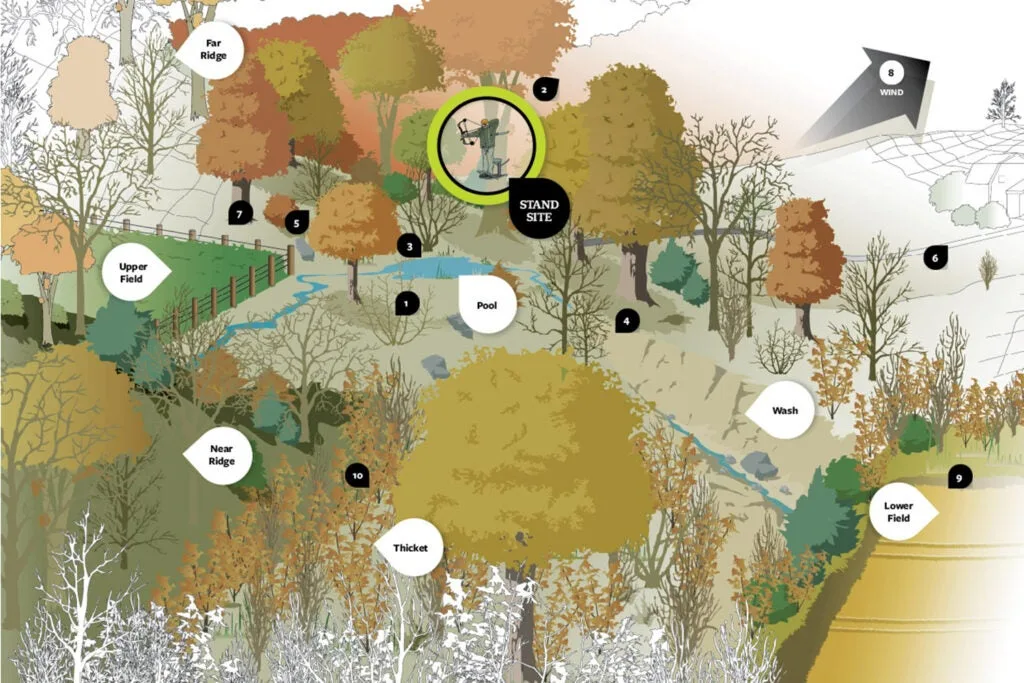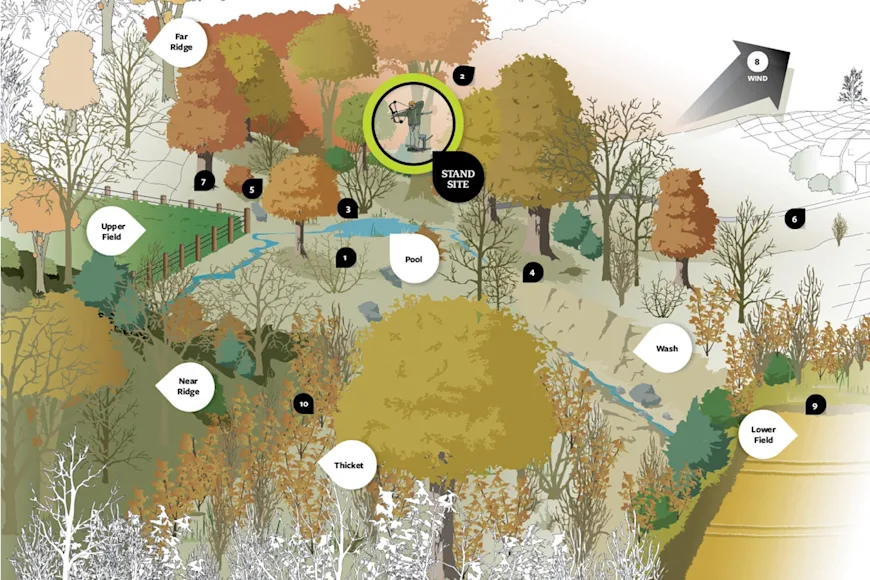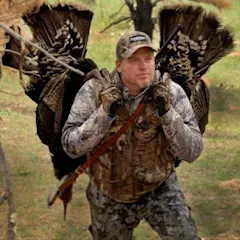_We may earn revenue from the products available on this page and participate in affiliate programs. Learn more ›
_
“Have no fear of perfection—you’ll never reach it,” said Salvador Dali, who was no deer hunter but certainly spoke as if he’d spent some time in the woods. That’s because you will not likely ever find the perfect deer stand—but you will kill more and bigger bucks by looking for it. The illustration here shows one hypothetical version, with 10 key elements highlighted. The more you can put together in the same spot, the closer you are to perfection—and to bagging the buck of a lifetime.

The 10 elements of a whitetail hotspot. Flying-Chilli.com
1. Deer HubThere are certain places in the deer woods where everything comes together. This is one. All the most likely travel corridors—the two wooded ridges, the upper field’s fencelines, the creek, and the wash—point to or lead past this stand. Whether bucks are moving routinely from bed to feed or roving unpredictably for does during the rut, they’re bound to pass this spot, making it hot all season.
In the big woods, look for intersections of ridges, old logging roads, skidder trails, creeks, and habitat edges. Every deer hunter knows to look for travel corridors. The best ones find hidden hubs from which buck routes emanate like spokes on a wheel.
2. Scent BlockerYou can shower up, spray down, and shell out for carbon clothing if you like. But the best way to keep your funk from a buck’s nose is to position your stand so there’s a sharp decline straight downwind. This way, the prevailing breeze carries your scent above any deer that approach from that direction, or circle your stand in response to calls or rattling. (Just don’t expect it to work when thermals are falling on dead calm days.) The next best thing is to set up where an open field, a steep bank, deep water, or other obstruction discourages bucks from getting downwind of you in the first place.
3. Buck StopA perfect stand is worthless if you miss the shot. So increase your odds of shooting at a standing, broadside buck by positioning your stand within easy range of a place where a deer will slow down or halt for a brief time. For example, a buck will stop for a quick bite at an isolated food source such as a fruit tree, pause to drink from a small pond or pool, and hesitate before jumping over a fence. Lacking these, consider digging a small pond, putting in a mineral lick (where legal), or making some mock scrapes.
4. All Funnels Are Good—but Hard Funnels Are BestA low brushy swale or a line of dark timber may encourage bucks to travel in a certain direction. On the other hand, a deep river, rock face, or sheer dropoff pretty much requires it. This steeply cut wash is a good example; it just about forces deer toward its head—where your stand is located.
5. Trail’s BendA buck that can travel into the breeze is more likely to move during daylight…but you and your buck can’t both have the wind, right? Actually, if you look hard, you can sometimes find a bend in a buck’s route that allows you to have it both ways—or at least close enough. Here, a buck that beds on the far ridge quarters into the wind as he descends, but once he turns toward the pond, you have the advantage. Likewise, a buck returning to the near-ridge bed from the lower feed field can expect to have the wind once he gets past your stand. But he won’t get past your stand.
6. Easy In, Easy OutNo stand can even approach perfection unless you can get in and out of the area without spooking deer. Here, a farm road leads to the back side of the hill behind your perch. It could just as easily be a creek bed, an irrigation ditch, a skidder trail, or a four-lane highway. The road leads to where you can quietly slip in and out, avoiding all bedding and feeding areas and leaving no residual scent anywhere deer are apt to travel.
7. Check StationA stand located on a hub of funnels is likely to see good rut action, but if that same stand is also downwind of prime doe bedding and feeding areas, you may have the hottest spot in the November woods. Note the upper field’s northeast corner. Rutting bucks love to scent-check open feeding areas for hot does just downwind of places like this. In big woods, look for similar scent-checking locations off clear-cuts and beaver-pond openings.
8. Day TripLots of stands are either morning or evening hotspots, but the perfect stand is a great place to sit early, late, or all day long. The key is to set up so the prevailing wind blows perpendicular to the basic line of deer travel. This not only lets you sit any time of day—it means that does or smaller bucks that walk past your stand don’t get directly downwind of you, where they might otherwise spook and alert that big buck that’s about to step into range.
9. Sound EffectIf you like to call and rattle, position your stand well above the deer, where sound will travel well. This stand, for example, is a great spot for rattling in the morning. The noises from your fake fight will fall into the lower field, where deer will be grabbing their last few bites; as well as into the doe bedding cover below, where bucks will linger looking for hot does as the rising sun chases them out of the open feed fields.
10. Nasty CoverIt doesn’t matter whether it’s composed of tangled blowdowns, brier thickets, cattail sloughs, or dense conifers. Big bucks find comfort in heavy cover, especially as hunting pressure builds through the season. That doesn’t mean they’re going to live in it 24/7. But they’ll be close, and you should be, too.
BONUS TIP: Where’s the Buck Sign?
You’d find loads of it in the location above. But it’s not pointed out for a reason: Buck sign comes and goes. Hot scrapes go cold in a week. Rub lines are abandoned during the rut. And the amount of spoor varies depending on habitat, deer densities, and buck-to-doe ratios. Hot buck sign can help confirm you’re in the right spot. But it does not a perfect stand make.


